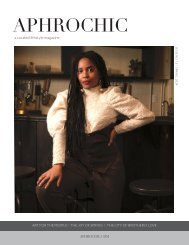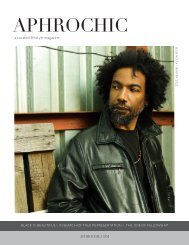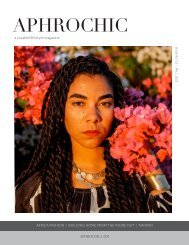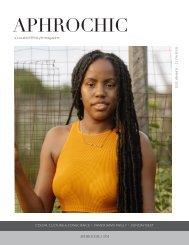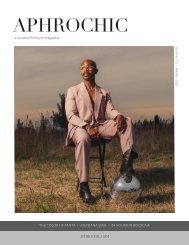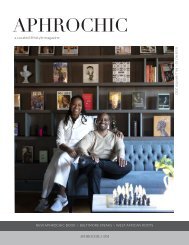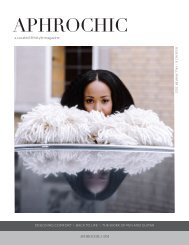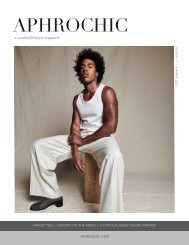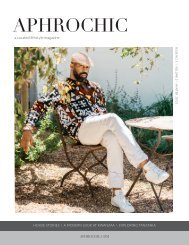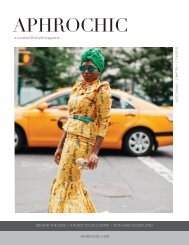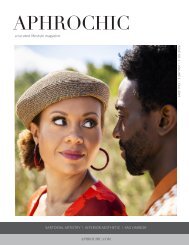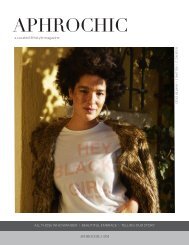AphroChic Magazine: Issue No. 4
In this issue, we sit down with artist, Malik Roberts, who relates the experience of creating one of the few African American artworks to sit permanently in the Vatican collection. Fashion designer, Prajjé Oscar John-Baptiste introduces his latest collection — an ode to Haiti, and its goddesses. We head to South Carolina to experience the Gullah-inspired music of Ranky Tanky. And in New York, we watch a new world being born with photographer and journalist, Naeem Douglass, who takes us inside the city’s Black Lives Matter protests, and economist Janelle Jones, who reminds us in these times that we are the economy. We are thrilled to share our cover with chef and musician, Lazarus Lynch. Inside, we talk with him about his cookbook, Son of a Southern Chef and his new album, I’m Gay. From a house tour in Brooklyn to a travel piece in Tobago, this issue takes you all over the Diaspora. And we see how of the concept of Diaspora was first introduced in a look back at how Pan-Africanism led the way to how we think of international Blackness today. It is a showcase of our culture, our creativity, our resilience, and our diversity, our demands for the present and our hopes for the future. Welcome to our summer issue.
In this issue, we sit down with artist, Malik Roberts, who relates the experience of creating one of the few African American artworks to sit permanently in the Vatican collection. Fashion designer, Prajjé Oscar John-Baptiste introduces his latest collection — an ode to Haiti, and its goddesses. We head to South Carolina to experience the Gullah-inspired music of Ranky Tanky. And in New York, we watch a new world being born with photographer and journalist, Naeem Douglass, who takes us inside the city’s Black Lives Matter protests, and economist Janelle Jones, who reminds us in these times that we are the economy.
We are thrilled to share our cover with chef and musician, Lazarus Lynch. Inside, we talk with him about his cookbook, Son of a Southern Chef and his new album, I’m Gay.
From a house tour in Brooklyn to a travel piece in Tobago, this issue takes you all over the Diaspora. And we see how of the concept of Diaspora was first introduced in a look back at how Pan-Africanism led the way to how we think of international Blackness today. It is a showcase of our culture, our creativity, our resilience, and our diversity, our demands for the present and our hopes for the future. Welcome to our summer issue.
Create successful ePaper yourself
Turn your PDF publications into a flip-book with our unique Google optimized e-Paper software.
Interior Design<br />
marked “no deposit, no return.” Or that the<br />
beautiful painting of yellow flowers hanging<br />
over the loveseat is actually three-dimensional<br />
and thickly ribboned with texture. Or that<br />
in place of wood, the fireplace has only a small<br />
electric light with a neon filament spelling out,<br />
“lamp.” There’s no end to the details, and no<br />
standard on how long it takes to notice them.<br />
But once noticed they become irresistible,<br />
enticing you to stare and daring you to look for<br />
more.<br />
Past the living room, the dining room is<br />
Paul’s image of a dinner under the sea. One of<br />
the first contrasts to be bridged here is the one<br />
between form and function, as the lighting<br />
over the dining table is a work of art in itself,<br />
and the centerpiece of the concept. “I always<br />
had this vision of people kind of living in art —<br />
that art is around you — and so I wanted to have<br />
this fantasy dinner where art is everywhere.”<br />
Beginning with the idea of eating underwater<br />
with jellyfish all around, the light, which was<br />
originally a single jellyfish, became several.<br />
The form and function motif continues around<br />
the table as, capped by mid-century bentwood<br />
chairs at the head and foot, the seating along<br />
the sides is equipped with back rollers to<br />
keep guests comfortable as they sit and chat.<br />
Because dinner beneath the sea is pointless<br />
without any interesting creatures in attendance,<br />
another of the artist’s unique creations<br />
stands sentinel at the far end of the room. With<br />
only one of its two legs attached to the pedestal,<br />
the piece was originally intended as a commentary<br />
on balance. But when inspiration hit to<br />
use rolled foam to add a larger head, something<br />
new was born. It was the kind of spur-of-themoment<br />
creativity that Paul relies on to keep<br />
things interesting.<br />
“You have to take risks to make art,<br />
because sometimes it’s the accident that makes<br />
it great,” he says. “The first thing is to be open<br />
as an artist, open your mind to everything and<br />
look at everything, and be curious. Examine everything<br />
and pay attention to everything.” It’s<br />
this openness that allows space for all of the<br />
contrasts Paul builds into the decor of each<br />
room on a small level, and between rooms and<br />
floors on a larger scale. “I have a certain feel on<br />
one floor and a different feel on another. Every<br />
room is special to me in different ways.”<br />
Upstairs the decor takes a step away from<br />
the sublime and into the realm of memory.<br />
The library, one of Paul’s favorite spaces in the<br />
entire home, speaks specifically to the memory<br />
of his godparents. “The library came from my<br />
godparents, who I lived with when I first came<br />
to New York,” he remembers. “They were very<br />
kind of radical, political, very Black Panther<br />
kind of people. So when they passed away a<br />
couple of years ago, I decided that I wanted<br />
to remember them very, very much. So we<br />
literally took the library out of their house, bitby-bit,<br />
and we gently brought it all here and<br />
put it all together and recreated that room and<br />
the memory of them. That was really very, very<br />
important to me.”<br />
Memory plays a role in the bedroom as<br />
well. Amid the tropical colors and modern<br />
lines that define one of the home’s most resolutely<br />
contemporary spaces, one playfully<br />
designed art piece disguises a dresser as a stack<br />
of “Pablo” (Paul’s nickname) brand bananas.<br />
The piece is a call-back to both the bodegas he<br />
frequented after late nights of bartending in<br />
his early days in New York and to his childhood<br />
home in Kingston, Jamaica. This blending of<br />
memories is another feature common to both<br />
his art and his design.<br />
“I question my existence a lot,” he begins.<br />
“And so, I look back at my past to get some of<br />
why I do this, why am I attracted to texture,<br />
why am I attracted to the earth. I grew up in this<br />
area of Jamaica that had a lot of mango trees and<br />
cherry trees and plum trees, and that’s one of<br />
the things I miss most about the Caribbean …<br />
it’s like you literally can wallow in the nature,<br />
like it’s all over you. That’s more my aesthetic.<br />
It’s a mix of the nature of the Caribbean and the<br />
man-made of New York. And I kind of mix that<br />
together in a way, like blend it in a blender and<br />
just kind of spit it out.”<br />
The outdoor spaces behind the house are<br />
as much a fantasy as the rooms within it. The<br />
first is an enclosed dining area that combines<br />
modern seating with a table lined with an assortment<br />
of Paul’s sculpted characters. The<br />
enclosure is perfect for those days when the<br />
44 aphrochic




